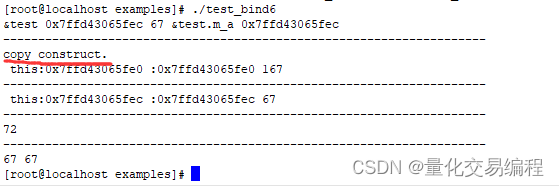一、在讲解std::bind之前,我们先来复习下std::function。
std::function 是一个“可调用对象”包装器,是一个类模板,可以容纳除了类成员函数指针之外的所有可调用对象,它可以用统一的方式处理函数、函数对象、函数指针,并允许保存和延迟它们的执行。
什么是可调用对象?
(1)函数指针
(2)具有operator()成员函数的类对象(传说中的仿函数),lambda表达式
(3)可被转换为函数指针的类对象
(4)类成员(函数)指针
(5)bind表达式或其它函数对象
比如:
// 普通函数
int add(int a, int b){return a b;}
// lambda表达式
auto mod = [](int a, int b){ return a % b;}
// 函数对象类
struct divide{
int operator()(int denominator, int divisor){
return denominator/divisor;
}
};用std::function将上述类型保存起来:
std::function a = add;
std::function b = mod ;
std::function c = divide(); 二、std::bind
可将std::bind函数看作一个通用的函数适配器,它接受一个“可调用对象”,生成一个新的可调用对象来“适应”原对象的参数列表。
std::bind主要有以下两个作用:
(1)将可调用对象和其参数绑定成一个防函数;
(2)只绑定部分参数,减少可调用对象传入的参数。
1、绑定普通函数
double divide (double x, double y) {
return x/y;
}
auto divide_half = std::bind (my_divide,_1,2);
std::cout << fn_half(10) << std::endl; // 输出5(1)bind的第一个参数是函数名,普通函数做实参时,会隐式转换成函数指针。因此std::bind (divide,_1,2)等价于std::bind (÷,_1,2);
(2)_1表示占位符,位于
2、绑定成员函数
#include
#include
using namespace std;
struct foo {
void sum(int n1, int n2)
{
std::cout << n1 n2 << std::endl;
}
static int staticmember(int a) {
return 66 a;
}
int data = 10;
};
int main() {
foo foo;
auto f = std::bind(&foo::sum, &foo, 95, std::placeholders::_1);
f(5); // 输出100
} (1)bind绑定类成员函数时,第一个参数表示对象的成员函数的指针,第二个参数表示对象的地址。
(2)必须显示的指定&foo::sum,因为编译器不会将对象的成员函数隐式转换成函数指针,所以必须在foo::sum前添加&;
(3)使用对象成员函数的指针时,必须要知道该指针属于哪个对象,因此第二个参数为对象的地址 &foo;
3、绑定静态成员函数
auto fun2 = &foo::staticmember;
cout<
4、绑定成员变量
#include
#include
using namespace std;
class testclass4 {
public:
testclass4() : m_a(100)
{}
public:
int m_a;
};
int main() {
testclass4 test4;
auto fun4 = std::bind(&testclass4::m_a, std::placeholders::_1);
int var = fun4(test4);
std::cout<
5、绑定仿函数
#include
#include
using namespace std;
class testclass5 {
public:
testclass5() = default;
testclass5(const testclass5& obj) {
std::cout<<"testclass5 copy construct."<
6、绑定成员函数时,哪些做法会先调用“拷贝构造函数” ?
#include
#include
using namespace std;
class testclass {
public:
testclass(int a):m_a(a){}
testclass(const testclass& obj) {
m_a = obj.m_a 100;
std::cout<<"copy construct."<
执行结果:

7、传引用参数的问题
当需要把对象传到bind中的参数中时,需要使用ref或者cref。
#include
#include
using namespace std;
using namespace placeholders;
void alter(int &a, int b) {
a = b;
}
int main() {
int a = 5;
auto f1 = bind(alter, a, _1); //此处bind中的参数a只是a的一个拷贝,而不是a的引用
f1(9);
cout << a << endl; //所以此处a仍为5
auto f2 = bind(alter, ref(a), _1); //使用ref可以将a的引用传递给bind
f2(9);
cout << a << endl; //所以此处a变成了9
return 0;
}
8、指向成员函数的指针
#include
struct foo {
int value;
void f1() { std::cout << "f1(" << this->value << ")\n"; }
void f2() { std::cout << "f2(" << this->value << ")\n"; }
};
void apply(foo* foo1, foo* foo2, void (foo::*fun)()) {
(foo1->*fun)(); // call fun on the object foo1
(foo2->*fun)(); // call fun on the object foo2
}
int main() {
foo foo1{1};
foo foo2{2};
apply(&foo1, &foo2, &foo::f1);
apply(&foo1, &foo2, &foo::f2);
}
(1)成员函数指针的定义:void (foo::*fun)(),调用时传递的实参: &foo::f;
(2)fun为类成员函数指针,所以调用时要通过解引用的方式获取成员函数*fun,即(foo1->*fun)()。